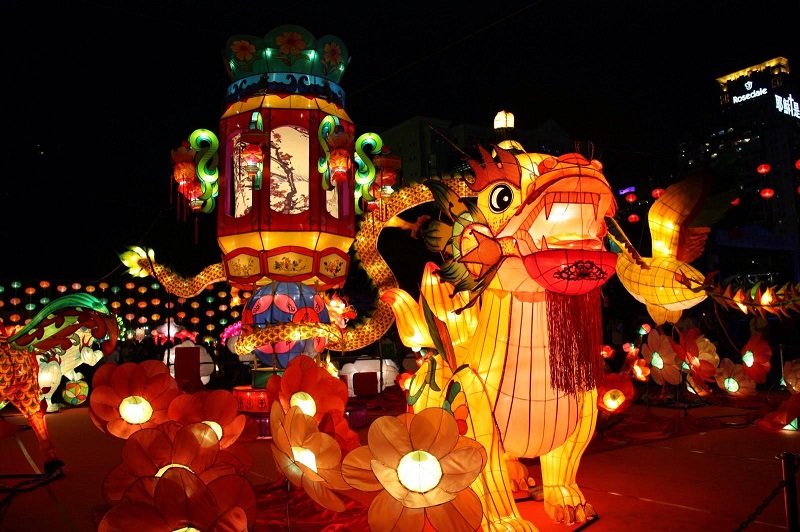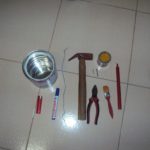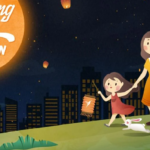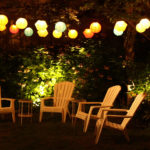The Mid-Autumn Festival is a significant cultural event for the Vietnamese, with a rich history and traditions. It is a time when families come together to honor their ancestors and celebrate with delicious food and festive activities.
On this day, people prepare special dishes and offer sacrifices to their ancestors. Adults indulge in moon-viewing parties, drinking wine and singing traditional songs, while children carry colorful lanterns, watch lion dances, and enjoy an abundance of sweets and fruits displayed by their parents under the moonlight.
The festival’s origins are steeped in folklore, with several legends associated with it.
1 The Legends of the Mid-Autumn Festival
The Tale of the Moon-Visiting Emperor
One such legend revolves around Emperor Ming Huang of the Tang Dynasty. On the 15th day of the 8th lunar month, the emperor strolled through the royal garden and encountered a Taoist priest named La Cong Vien, also known as Diệp Pháp Thiện. With his magical powers, the Taoist priest transported the emperor to the moon palace.
There, the emperor beheld an even more breathtaking sight. He delighted in the ethereal music and dance performed by graceful fairies dressed in colorful, flowing robes. Enraptured by the otherworldly beauty and sounds, the emperor lost track of time until the Taoist priest reminded him that dawn was approaching.
 The Moon-Visiting Emperor Legend
The Moon-Visiting Emperor Legend
Upon his return to the earthly realm, the emperor, still enchanted by the celestial experience, commissioned a special dance and music composition to commemorate his magical journey. He ordered that every year, on the 15th day of the 8th lunar month, the people should hold lantern processions and feasts to mark the occasion, while he and his beloved concubine, Yang Guifei, would drink wine and watch the moon, reminiscing about his extraordinary trip to the moon palace.
Thus, the tradition of lantern processions and festive celebrations during the Mid-Autumn Festival took root in Vietnamese culture.
Some believe that this tradition also stems from the birthday of Emperor Ming Huang. As his birthday fell on the 15th day of the 8th lunar month, the Tang Dynasty decreed that people throughout the land should hang lanterns and hold feasts to commemorate the occasion.
The Legend of Chang’e and Houyi
Another legend associated with the Mid-Autumn Festival tells the tale of Chang’e and Houyi, a couple who were once immortal gods living on the moon. Houyi, a skilled archer, saved the earth from being scorched by ten suns, the sons of the Jade Emperor, by shooting down nine of them. As a reward, the Jade Emperor bestowed upon him an elixir of immortality.
 The Legend of Chang’e and Houyi
The Legend of Chang’e and Houyi
Houyi brought the elixir home and hid it in a box, warning his wife, Chang’e, not to open it. However, while he was away, Chang’e’s curiosity got the better of her, and she swallowed the elixir. Just as Houyi returned, it was too late to stop her, and Chang’e ascended to the moon, leaving her husband behind. Despite their mutual longing, Chang’e could not return to the earthly realm.
Houyi, consumed with grief, built a palace in the sun and named it “Yang,” while Chang’e did the same on the moon, naming it “Yin.” Once a year, on the 15th day of the 8th lunar month, the separated couple would be reunited in happiness.
The Legend of Cuoi, the Moon Festival’s Jester
In Vietnamese folklore, Chang’e is linked with Cuoi, a jovial character who loved to tell tall tales. One day, Chang’e, a beautiful fairy who often defied the rules to play with children on earth, met Cuoi. He taught her a unique way to make delicious and attractive mooncakes by mixing all the ingredients and baking them.
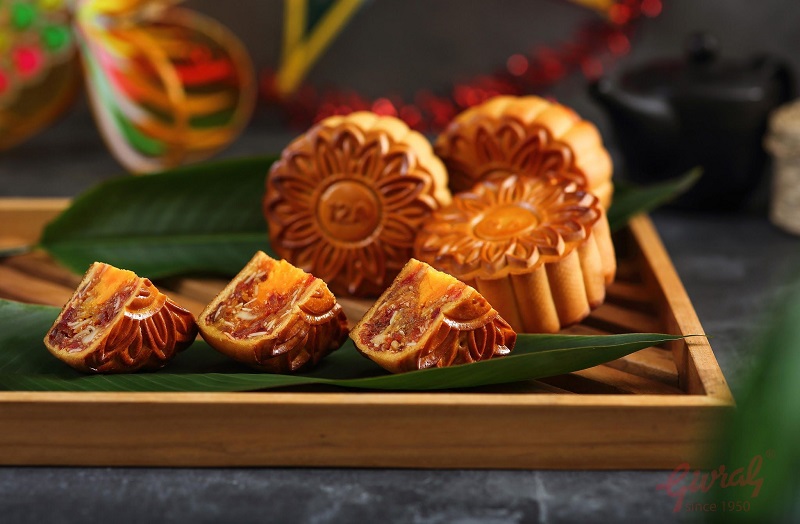 Cuoi teaching Chang’e how to make mooncakes
Cuoi teaching Chang’e how to make mooncakes
Chang’e returned to the moon with these mooncakes and entered a baking competition. Cuoi, unable to let go of Chang’e, held onto her hand, and a mysterious force pulled them both, along with the banyan tree at the village entrance, up to the moon. Perched on the tree, Cuoi could see the children playing below, and he would often cry, feeling homesick.
 Cuoi sitting on the moon, feeling homesick
Cuoi sitting on the moon, feeling homesick
Chang’e’s mooncakes won first place, and she wished that every year on the 15th day of the 8th lunar month, she and Cuoi could descend to earth to play with the children. Thus, the Jade Emperor named this occasion the “Mid-Autumn Festival,” a joyous celebration for children.
2 The Significance of the Mid-Autumn Festival
For the Vietnamese, the Mid-Autumn Festival holds a unique significance that sets it apart from the celebrations of the Chinese community.
Family Reunions on Mid-Autumn Night
In Vietnamese culture, the Mid-Autumn Festival is a time for families to reunite and honor their ancestors. All family members come together to prepare special dishes and offer sacrifices to their forefathers.
As the night falls and the earth is bathed in golden moonlight, neighborhoods gather to sip green tea, savor mooncakes, and admire the full moon. It is also customary to display an array of fruits and sweets for children to enjoy while they participate in lantern processions, lion dances, and other festive activities.
Additionally, people often buy mooncakes, tea, and wine to offer to their ancestors and present gifts to their elders, teachers, friends, and benefactors. This festival provides an opportunity for younger generations to express gratitude and for people to strengthen their bonds of care and friendship.
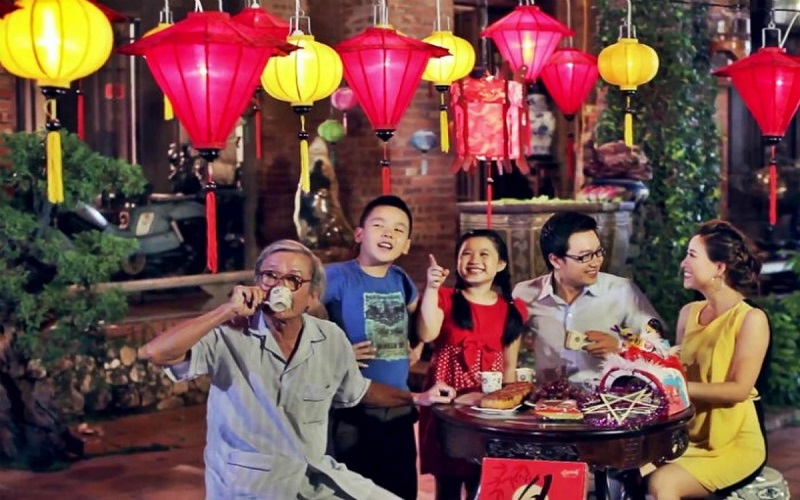 Families reunite and honor their ancestors during the Mid-Autumn Festival
Families reunite and honor their ancestors during the Mid-Autumn Festival
Lion Dances During the Mid-Autumn Festival
While the Chinese community often performs lion dances during the Lunar New Year, the Vietnamese reserve this tradition specifically for the Mid-Autumn Festival. The lion is considered a symbol of good luck and fortune.
In the past, the Vietnamese also organized Trống Quân singing during this festival. This traditional singing followed a rhythm of “thình, thùng, thình,” with young men and women singing verses to each other as a form of courtship.
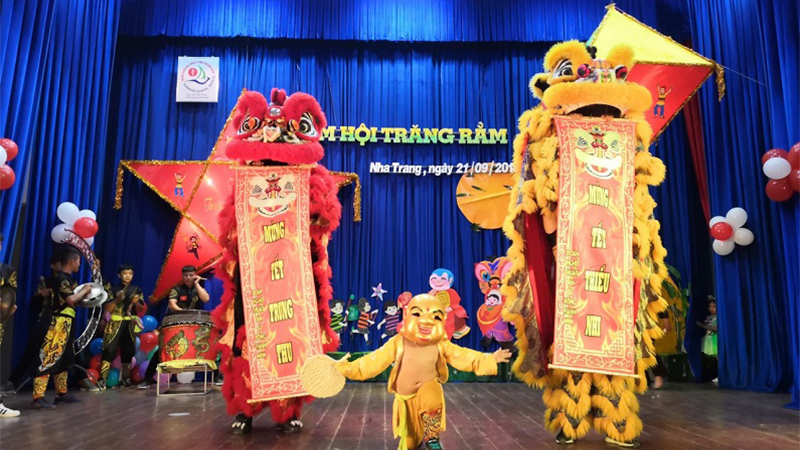 Lion dance during the Mid-Autumn Festival
Lion dance during the Mid-Autumn Festival
The Mid-Autumn Festival Brings People Together
The Mid-Autumn Festival serves as a platform for young men and women to interact and choose potential life partners. They sing verses in the traditional “lục bát” poetic form or its variations.
Initially, the Mid-Autumn Festival was primarily celebrated by adults who appreciated the beauty of nature, savored mooncakes, and drank tea while admiring the full moon. Over time, it evolved into a children’s festival, although adults continue to play a significant role in the festivities.
Children eagerly anticipate this festival as it offers them a chance to indulge in lantern processions, singing, and feasting on treats prepared by their elders, without the usual restrictions. It is a time when parents allow their children to enjoy sweets without reprimand.
The Mid-Autumn Festival embodies the values of care, filial piety, gratitude, friendship, reunion, and love. It is a cherished tradition that brings people together and strengthens the bonds of community and family.
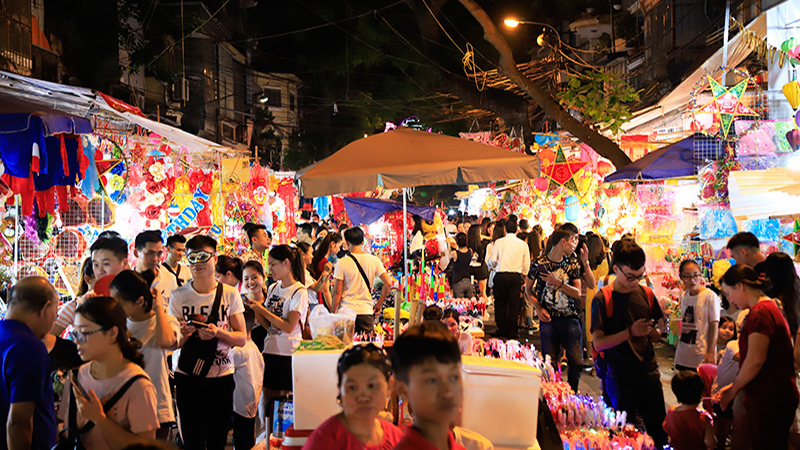 The Mid-Autumn Festival brings people together
The Mid-Autumn Festival brings people together
We hope that through this article, you have gained a deeper understanding and appreciation of the Mid-Autumn Festival and its significance in Vietnamese culture!
Crafting a Milk Jug Lamp: A Joyful Activity for the Entire Family
Bring some fun and sparkle to this year’s Mid-Autumn Festival with an eco-friendly tin can lantern! Encourage your children to think outside the box and get creative with a sustainable art project that will set the mood for a magical celebration. Get ready to follow this easy tutorial and make an enchanting toy that is sure to make your little ones smile.
10 Ideas for Creating a Memorable Mid-Autumn Celebration in the Comfort of Home
The traditional Mid-Autumn Festival celebration has been disrupted this year due to the coronavirus pandemic, leaving families unable to gather to observe the holiday together. To bring a sense of festive cheer into their homes, parents are turning to creative solutions and decorating for the occasion. In this article, we offer ideas and advice on how to craft the perfect Mid-Autumn Festival environment within the home safely and securely. Read on to find out more!

























